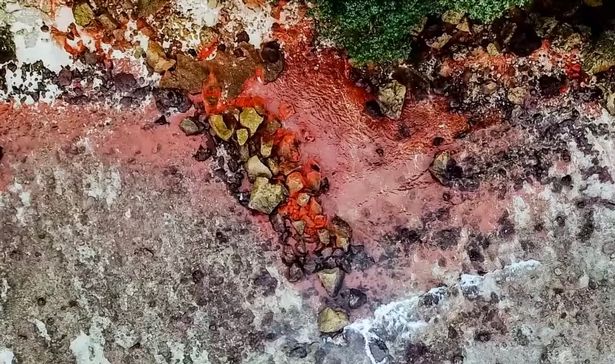The usual crystal blue waters of a stunning tropical island are being stained blood red – and scientists have discovered it’s actually a spectacular natural phenomenon.
Eerie aerial pictures taken of the area, 235 miles off the coast of Indonesia, show the sand, rocks and shallow waters running mysteriously bright red.
Experts on the Science Channel, which featured the startling discovery on its YouTube channel, described the usually picturesque shoreline as “very frightening”.
They suggested the mass is “alive” and moving up onto the land – just like a scene from a 1950s horror movie.
Scientists have been speculating what could have created such a bright pigmentation of the beachfront, with zoologist Dr Eleanor Spicer Rice fearing the worst.
“It looks like there’s blood filling the water,” she said.The gruesome sight reminded Hayley Chamberlain, biologist, of a “disturbing event’ she had seen on the Danish Faroe Islands, more than 7,500 miles away, and has led experts to speculate on what could be causing the crimson tide.
Every year on the cluster of 18 islands in the middle of the North Atlantic Ocean, north west of Scotland and halfway between Iceland and Norway, there is a slaughter of pilot whales in a tradition dating back hundreds of years.
The video cuts to disturbing images of people tying whales up with rope and repeatedly stabbing them as they fight for escape from the brutal torture.
“It’s going to turn whatever ocean colour you have into a red, bloody mess,” she said.
Today, the islands’ inhabitants hunt the whales solely for their meat, which the chief of police divides up between the local population
Experts then speculated that the bloody-looking beach on the island could be similar evidence of a mass slaughter.
However, on further investigation they found the area, known as Christmas island, is part of an anti-whaling Australian territory and therefore it is unlikely to be a slaughter spot.
The mystery of the red beach deepened when scientists found the stained hues are coming from the water, rather than land.
“Whatever this red mass is, it’s moving, it’s alive,” said wildlife biologist Dr Stephanie Schuttler.
“Perhaps what we’re looking at here is a migration.”
Experts discovered the answer – and were surprised to find it wasn’t as sinister as they’d first suspected.
The red area is an invasion of millions of tiny, red crabs moving in a “marching army” in conjunction with a lunar cycle.
The adult crustaceans move from land towards the ocean during mating season, bringing the whole island to a standstill as they block roads and paths.
Making their way to the beach, the male crabs dig ‘love nests’ in the sand while females head into the ocean to lay hundreds of thousands of eggs.
The babies then make their way on mass from the waters to the land, creating what looks like a red wave.
“It’s one of the weirdest, most awe-inspiring sights in nature,” said Dr Spicer Rice.
Hayley added: “It’s such a beautiful biological event.”
UK Mirror
You may be interested

Arsenal Equal Chelsea’s London Derby Feat After 5-1 Win Vs Palace
Webby - December 21, 2024Arsenal equaled Chelsea’s London derby achievement following their 5-1 win against Crystal Palace in Saturday’s Premier League game at Selhurst…

Haaland Backs Guardiola To Turn Man City’s Poor Form Around
Webby - December 21, 2024Erling Haaland had said he and his Manchester City teammates are still backing manager Pep Guardiola to turn the team’s…

PSG To Reignite Interest In Osimhen
Webby - December 21, 2024Paris Saint-Germain have contacted Napoli to discuss signing Victor Osimhen in January, according to reports in France.It is reported that…




















![American Pastor, David Wilson Seen Eating The Box Of Woman Who Isn’t His Wife [Video]](https://onlinenigeria.com/wp-content/uploads/2019/10/american-pastor-david-wilson-seen-eating-the-box-of-woman-who-isnt-his-wife-video-150x150.jpg)









